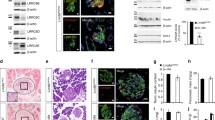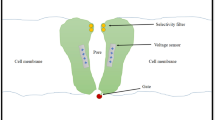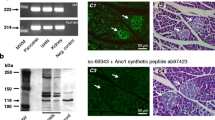Abstract.
Cell-attached channel recordings were made of an inward channel current in isolated rat pancreatic β-cells incubated in the presence of diazoxide to clamp the membrane potential close to the K+ equilibrium potential. With 42 mM Cl– in the pipette solution, a channel of approximately 200 pS was observed in 20–40% of patches which conducted an inward current at a pipette potential of 0 mV. The channel was activated by a rise in glucose concentration over the range 5–20 mM. The channel was also activated by methylglyoxal, possibly due to its metabolism to D-lactate, but not by the non-metabolizable glucose analogue 3-O-methyl glucose. The channel was activated by hypotonic cell swelling and was sensitive to inhibition by the anion channel blockers 4,4'-dithiocyanatostilbene-2,2'-disulphonic acid, 5-nitro-2-(3-phenylpropylamino) benzoic acid and 4-hydroxytamoxifen. Current reversal occurred at a pipette potential of approximately –67 mV. Raising [Cl–] in the pipette solution to 142 mM shifted the reversal potential to –52 mV. It is suggested that the channel is the volume-sensitive anion channel previously described in insulin-secreting cells. Activation of the channel by glucose could be important in generating a depolarizing current leading to increased electrical activity and insulin release, particularly at higher concentrations of glucose where KATP channel activity is minimal.
Similar content being viewed by others
Author information
Authors and Affiliations
Additional information
Electronic Publication
Rights and permissions
About this article
Cite this article
Best, L. Study of a glucose-activated anion-selective channel in rat pancreatic β-cells. Pflugers Arch - Eur J Physiol 445, 97–104 (2002). https://doi.org/10.1007/s00424-002-0893-y
Received:
Accepted:
Issue Date:
DOI: https://doi.org/10.1007/s00424-002-0893-y




